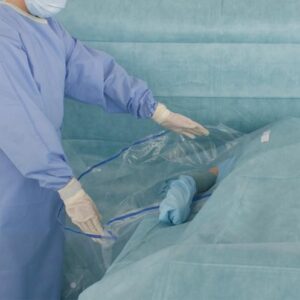What Are Sterile Drapes And What Should You Know When Handling Them?

Sterile drapes are not just another hospital supply. They are used in both hospital and outpatient settings, and they’re essential to ensure sterile conditions are met during surgical procedures. But what do sterile drapes look like, and what should you know when handling them?

What are sterile drapes?
Sterile drapes are a type of medical equipment that is used to create a barrier between a patient and any potential sources of contamination. This can include anything from the outside environment to the hands of healthcare workers. Sterile drapes are typically made from a material that is impermeable to bacteria and other microorganisms, such as polyethylene or polyurethane.
Who should use sterile drapes?
Sterile drapes are an important part of the doctors’ and nurses’ arsenal when it comes to protecting patients from infection. But who should use them?
The simple answer is that anyone who is coming into contact with a patient’s open wound should use sterile drapes. This includes surgeons, nurses, and other medical staff. No matter what type of sterile drape you use, it’s important to handle them with care.
Rules for handling a sterile drape
A sterile drape is a medical-grade cloth that is used to maintain sterility during surgical procedures. The drape is placed over the patient and any equipment that will come into contact with the patient or their incision site. Sterile drapes are usually made of an impermeable material such as plastic or paper.
There are some basic rules to follow when handling a sterile drape:
-Wash your hands thoroughly before handling the drape.
-Be sure that the side of the drape that will come into contact with the patient is facing up.
-Do not touch the side of the drape that will come into contact with the patient.
-Fold the drape in half, lengthwise, so that it can be easily carried to the procedure site.
-Place the folded drape on a clean surface such as a Mayo stand or table.
-Unfold the drape so that it covers the entire area of the procedure site.
How to properly remove a draped patient from a chair or bed
There are a few things to keep in mind when removing a draped patient from a chair or bed. First, be sure to grab the edges of the drape on either side of the patient. Second, make sure to lift the drape straight up and not at an angle. If you lift at an angle, you risk the drape tearing. Finally, be careful not to let the drape touch anything else in the room, as this could contaminate it.
Conclusion
Sterile drapes are an important part of keeping a surgical area clean and free of infection. If you are handling sterile drapes, it is important to know how to properly handle them so that they remain sterile. We hope that this information has been helpful and that you will be able to keep your surgical area safe and clean. If you need sterile drapes or you need more information about them, please feel free to contact Winner Medical.





